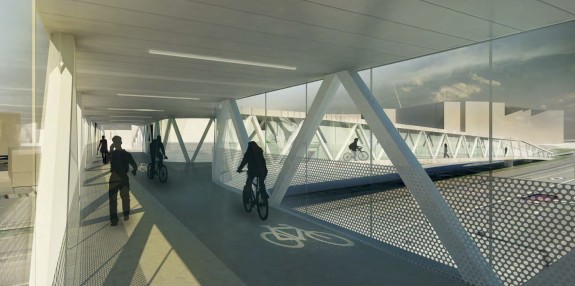
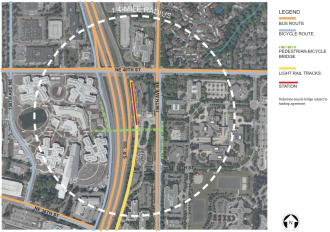 Microsoft will fund a walking and biking bridge over Highway 520, connecting the western part of their campus and the 520 Trail to the future location of the Overlake light rail station.
Microsoft will fund a walking and biking bridge over Highway 520, connecting the western part of their campus and the 520 Trail to the future location of the Overlake light rail station.
The software giant has agreed to contribute $33.3 million dollars toward station-related work, the majority of it going to the biking and walking bridge. The agreement, which would be the company’s largest ever expenditure on a transportation project, still needs to go to the City of Redmond and the Sound Transit Board, the Seattle Times reports.
If all goes according to schedule, the walking and biking bridge could open as soon as 2020, three years before the light rail trains begin running. But that’s just fine for Microsoft. The bridge will not only help connect people to the light rail station, but it will also help knit together the company’s already bike-loving campus. From the Times:
“Over time we think it’s probably going to double the amount of ridership on the light-rail line,” said Jim Stanton, Microsoft senior community-affairs manager.
The bridge, to be located south of Northeast 40th Street, also would help knit together a 388-acre campus where nearly 40,000 employees work in buildings divided by a freeway, Stanton said.
This expenditure is the latest in a Puget Sound regional trend, with tech companies pitching in to help make their campuses more friendly for biking and walking. As part of a deal with the City of Seattle, Amazon will fund study and a portion of construction of protected bike lanes on 7th Ave in the Denny Triangle area.
It’s encouraging to see more and more public-private partnerships helping to accelerate biking and walking projects. After all, employees and/or customers want to walk and bike more, so it makes lots of sense for companies to help speed up needed safety and access projects.
Anyway, here are some more hot and steamy bike/walk bridge porn concept images:
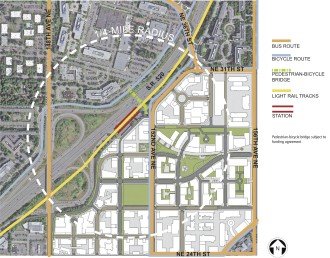 Correction: Originally, we had included the images below with the Overlake Transit Center bridge. They are in fact a separate bridge near the proposed Overlake Village Station (thanks Lee).
Correction: Originally, we had included the images below with the Overlake Transit Center bridge. They are in fact a separate bridge near the proposed Overlake Village Station (thanks Lee).
Microsoft has no plans to fund the Overlake Village Station bridge, but the City of Redmond is currently considering filling the $7 million budget gap to build it. The Overlake Village bridge has already received a $5 million grant through the Puget Sound Regional Council.

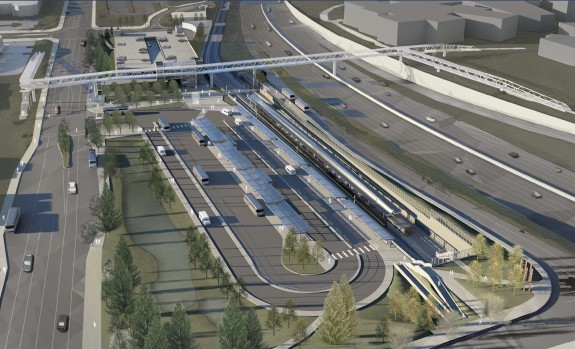

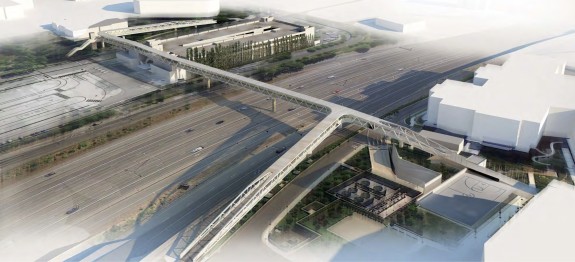
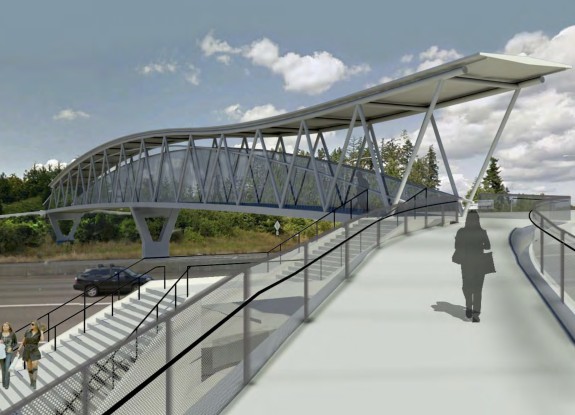
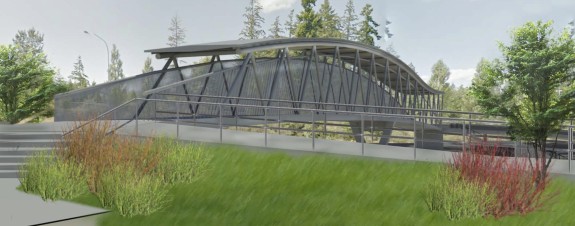







Comments
18 responses to “Microsoft offers to fund walk/bike bridge over 520 near Overlake Transit Center”
This is absolutely great stuff—it’s really horrible crossing at that overpass.
I’m surprised pedestrian bridges over freeways aren’t more commonly demanded by the citizens. I know nothing of the history of this, but it seems that Kirkland must have had some great walkability advocates in the early 1960s given that they have three pedestrian bridges (60th, 80th, and 100th Street) over I-405.
Looks like we’ll get at Northgate, but I’d love to see even more of these.
I don’t know about the others, but the 100th Street bridge was more recent than the ’60s. It was added at the request of local emergency services to improve response times, and neighbors thought a pedestrian ramp would be a good addition. Some people have trumpeted the bridge as a great example of cooperation between different concerns, though the design of the east end of the bridge leaves a lot to be desired for people biking.
This is a great example of how private funds can work when projects are in a company’s interest, but what happens when the need for pedestrian improvements is equally high in a residential or low-income area that no company has a stake in? My vision is for us to depend on private funds cautiously — they will never fully replace public funds designed to meet the highest need.
“the company’s already bike-loving campus”
I wouldn’t say it’s a “bike loving” campus. A look at how the 520 trail crosses 51st and 40th are great examples of how NOT to provide biking infrastructure. People are almost hit on bikes at these crossings every single day.
Also the roundabout with the last bridge we built over 520 is designed pretty poorly, expecting cyclists to transition to and from sidewalks (which I’m sure drivers just love). Here’s a street view of it: http://goo.gl/maps/DcYS3
The big problem at 51st and 40th is right-turning drivers (both on red from e-w streets and on green from the freeway ramp) encroaching on cyclists’ right-of-way due to lack of care and poor sight lines, right? I’m not there all that often, but that has been my impression of what’s dangerous when I have been there.
According to some thing linked from the SBB comments section a few months ago, global best-practice for one-lane roundabouts like the one near the 36th St. overpass is to give cyclists in a bike lane the option of merging with the traffic flow through the roundabout or taking the sidewalk. I think this roundabout basically fits the bill — I’ve never been there, but from the streetview I’m pretty sure in normal traffic conditions I’d merge left and move with traffic through the roundabout. If the road was super congested (if I was blowing by cars in the bike lane) and the sidewalks were clear I’d ramp up to the sidewalk (a similar maneuver to how most people on bikes approach the Fremont or Montlake bridges), ’cause, ya know, cyclists are steel-borne, we take what is ours (/game of thrones).
The main thing I see missing in the roundabout is shared lane markings. When a segregated facility routes onto a sidewalk, far too many drivers believe people on bikes are required to become sidewalk cyclists.
On the approach to the roundabout, where the bike lane line becomes dashed, there should be standard “Bikes May Use Full Lane” signs, followed by sharrows centered in the general purpose lane in the approach and within the roundabout.
Am wondering why the author thought it would be appropriate to include ‘porn’ in strikeout in this article, and the editor(s) let that go through… really? come on Seattle Times… that kind of verbage isn’t necessary — speaking for myself, it’s ok to mix up a little news and commentary (although I would prefer straight news on topics like this) … I don’t subscribe to read trash talk.
I am not the Seattle Times. For better and worse, I am my own editor.
“Porn” is used in this context to mean “pictures that will make people excited.” e.g. “Bike porn” means exciting, and sometimes desire inducing, images of bikes. It’s common usage, and we’re adults. (And even if we weren’t/aren’t, using the word “porn” in a non-porny way doesn’t hurt kids.)
Those are some hot pictures of bike/walk bridges!
Question – does the bridge connect to the stairs in the parking garage, or will you have to cross 156th St. twice to get from the train platform and the bus bays to the other side of the freeway?
The images in this post are from two Overlake light rail stations – Overlake Village (at 152nd, near the Microsoft-funded vehicular bridge) and Overlake Transit Center (at 156th and 36th/40th). Both of these will have pedestrian/bicycle bridges, but Microsoft will only be funding the Overlake Transit Center bridge. The Overlake Village station bridge is, I
There’s a lot more info about both stations and bridges at Sound Transit’s website:
Open house boards from November 2013:
http://www.soundtransit.org/Documents/pdf/projects/eastlink/20131125_Overlake_Village_Station.pdf
Staff presentation:
http://www.soundtransit.org/Documents/pdf/projects/eastlink/20131120_Overlake_PreFinal_Design.pdf
And if you want to comment:
http://www.soundtransit.org/Projects-and-Plans/East-Link-Extension/Project-Update–11212013
The City of Redmond is doing a lot of planning for new growth in Overlake Village (especially where Group Health used to be and where PS Business Parks is now). The plans are fairly bike-friendly, and very transit-rich. There’s more planning info than you can shake a stick at here:
http://www.redmond.gov/Residents/Neighborhoods/OverlakeVillageEmploymentArea/
My cut-off sentence above should have been, “The Overlake Village station bridge is publicly funded.”
Thanks for pointing that out. Silly me! I’ll correct the story.
Can I (at least as a pedestrian) get from the bridge onto the light rail platform directly or would I have to walk back?
[…] The Overlake Village project in Redmond would serve the Microsoft campus and the future site of a light rail station. Seattle Bike Blog reports that Microsoft already has promised to pump $33 million into the project. […]
[…] a funding perspective, Microsoft’s example builds off of a good precedent. As Bike Blog notes, Amazon has already taken the lead on funding streetcar service and bike facilities in South Lake […]
Headline revision: “Microsoft opts out of civic life by tax avoidance, only participates in things directly benefiting it.”
Same deal as the M$ private bus service. “We don’t want to pay to be part of society. We’ll help cram the roadways further, but we’ll get glowing PR puff at the same time. A win-win, for us.”
[…] $19.8 million to build the project, which also includes a pricey stormwater retention vault. As we reported previously, the funding gap for the bridge alone after federal grants was about $7 […]